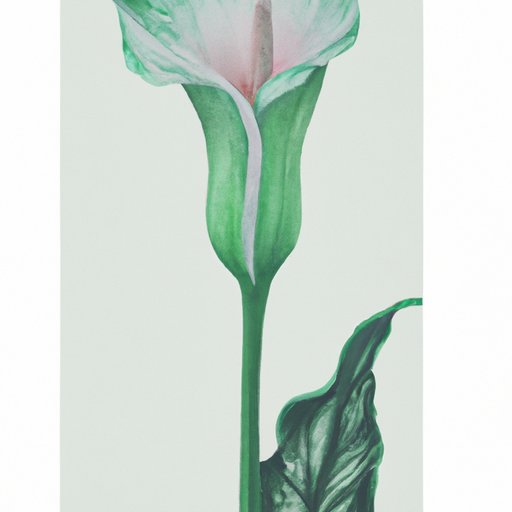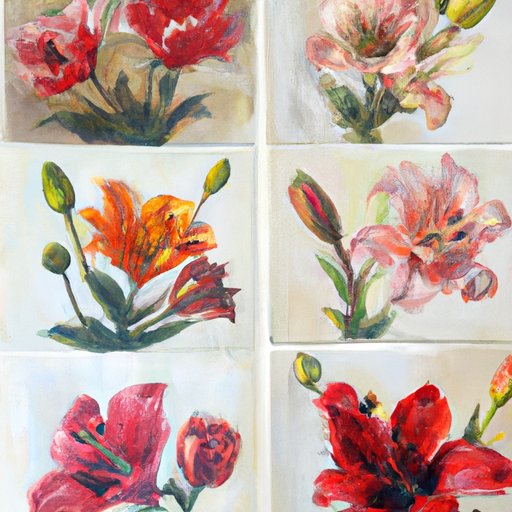
Introduction
Whether you’re a beginner or an experienced artist, painting flowers can be a daunting task. Flowers have been an important subject in art for centuries, and capturing their beauty on canvas can be a rewarding experience. In this article, we will explore the beginner’s guide to painting a flower, tips for capturing the beauty of flowers in your paintings, techniques for creating realistic representations, how to choose the right paints and brushes for flower painting, the joy of flower painting, breaking down the process into manageable steps, and the creative journey of painting a flower.
The Beginner’s Guide to Painting a Flower: Step-by-Step Tutorial
The first step in painting a flower is to gather the necessary materials and set up your workspace. You will need paint, brushes, canvas, and a palette. Once you have everything set up, it’s time to start painting.
The step-by-step process of painting a basic flower includes:
- Sketching the basic shape of the flower with a pencil or paintbrush.
- Blocking in the colors of the flower, starting with light colors and gradually building up to darker ones.
- Adding details such as texture and shadows.
- Finishing touches, such as highlights and outlining.
It’s important to remember that painting is a process and it may take time to create a finished piece. Don’t be afraid to make mistakes and try different techniques until you find what works best for you. Helpful visuals or graphics can also aid you in following the process.
10 Tips for Capturing the Beauty of Flowers in Your Paintings
To create beautiful flower paintings, observation and reference material are key. Here are 10 helpful tips for capturing the beauty of flowers in your paintings:
- Study the anatomy of flowers to better understand how they grow and how they can be represented on paper or canvas.
- Take time to observe flowers in different lighting situations and from different angles to better understand their unique qualities.
- Understand color theory and how to use complementary colors to create contrast and depth in your paintings.
- Pay attention to the details of the flower, such as its texture and petal size and shape.
- Consider the mood you want to convey in your painting and use color and composition to help achieve it.
- Use light and shadow effectively to add depth and dimension to your painting.
- Don’t be afraid to simplify complex subjects to create a more impactful image.
- Capture the essence of the flower and its unique personality instead of worrying about being too technically correct.
- Experiment with different brushstrokes and techniques to find what works best for you.
- Practice, practice, practice. The more you paint, the better you’ll become at capturing the beauty of flowers in your paintings.

Painting Flowers from Life: Techniques for Creating Realistic Representations
One of the best ways to improve your flower painting skills is to paint from life. Painting from life allows you to better understand the unique qualities of flowers and how to represent them in your work.
To paint flowers from life:
- Set up a still life with a vase, flowers, and lighting that allows you to capture the details of the flowers you want to paint.
- Take time to study the flowers, paying attention to their unique qualities and features.
- Simplify the subject matter to create a more impactful image.
- Create depth and dimension in your painting by using light and shadow effectively.
- Don’t be afraid to experiment with different techniques and brush strokes to create a unique texture.
How to Choose the Right Paints and Brushes for Flower Painting
Choosing the right materials is essential for successful flower painting. Using the wrong type of paint or brush may lead to frustration and a less than desirable final product.
The paints and brushes that work best for flower painting include:
- Acrylic or oil paints
- Synthetic or natural hair brushes
- Round or filbert brushes for smaller flowers
- Flat or angular brushes for larger flowers
When choosing paints, be sure to select colors that accurately reflect the flower you’re painting. Brushes should be selected based on their size and shape, and how they fit with the subject matter. Having a good set of materials is essential to make the painting experience more enjoyable.
The Joy of Flower Painting: Tips for Enjoying the Process and Producing Stunning Results
While it’s important to focus on creating a beautiful final product, it’s equally important to enjoy the process of painting flowers. Here are a few tips for finding joy in flower painting:
- Find inspiration in nature or in photographs.
- Choose colors that make you happy and reflect your personality.
- Take breaks when needed to avoid burnout or frustration.
- Remember to have fun and not to be too hard on yourself. Painting is an enjoyable experience and should never be a cause of stress or anxiety.
Flower Painting Made Easy: Breaking Down the Process Into Manageable Steps
To make painting a flower more manageable, it’s important to break down the process into smaller, more achievable steps. Follow this helpful checklist:
- Sketch the basic shape of the flower with a pencil or paintbrush.
- Block in the colors of the flower, starting with light colors and gradually building up to darker ones.
- Add details such as texture and shadows.
- Add finishing touches, such as highlights and outlining.
By following these manageable steps, painting a flower can be a fun and enjoyable experience instead of a daunting task.
Idea to Artwork: The Creative Journey of Painting a Flower
Before even starting to paint, there is a journey, with ideas explored, concepts sketched and colors tested. The creative journey of painting a flower can be an exciting experience filled with exploration and discovery.
To begin the creative journey:
- Brainstorm ideas, considering different flowers, colors, and moods you want to convey in your painting.
- Sketch out initial concepts, exploring different compositions and ideas.
- Test out different colors and make adjustments as needed.
- Make final adjustments to your painting, tweaking details and colors as needed.
Enjoy the creative journey and don’t be too hard on yourself. Remember that great works of art often require exploration, mistakes, and growth. What matters is that you embrace the process and allow it to take free reign of your creativity.
Conclusion
In conclusion, painting flowers can be a rewarding and enjoyable experience for artists of all levels. By following these tips and techniques, you can capture the beauty of flowers in your paintings and create stunning works of art. Remember to enjoy the creative journey and don’t be afraid to make mistakes or try new things.
“The artist is a receptacle for emotions that come from all over the place: from the sky, from the earth, from a scrap of paper, from a passing shape, from a spider’s web.





